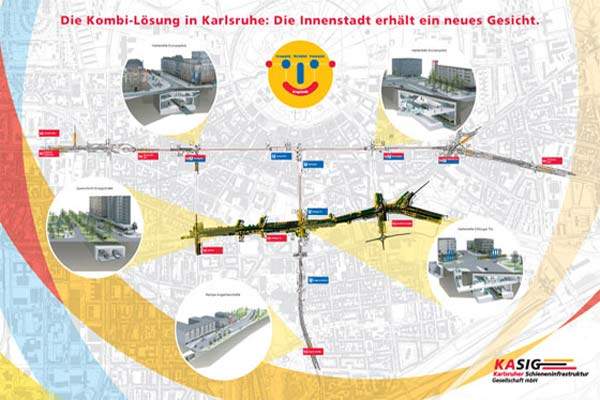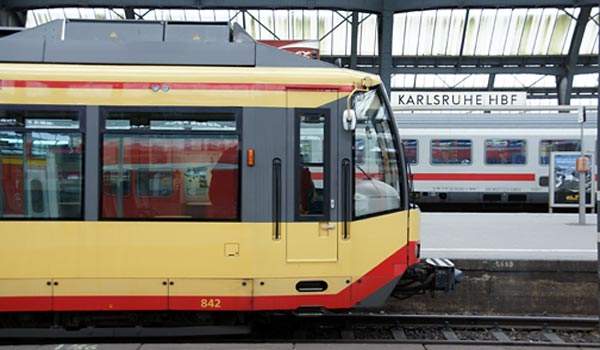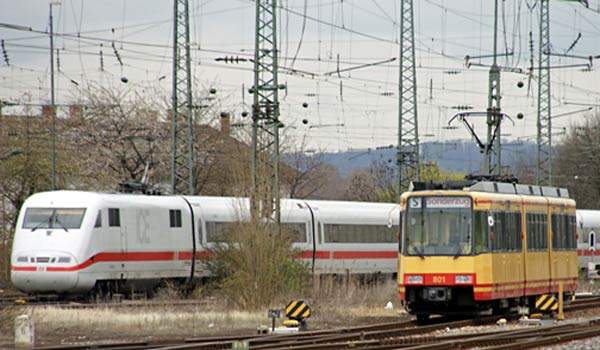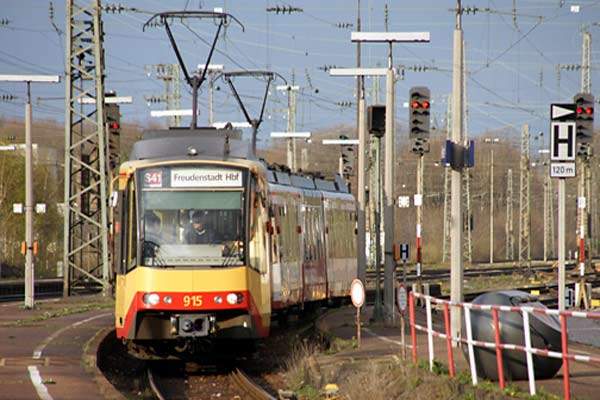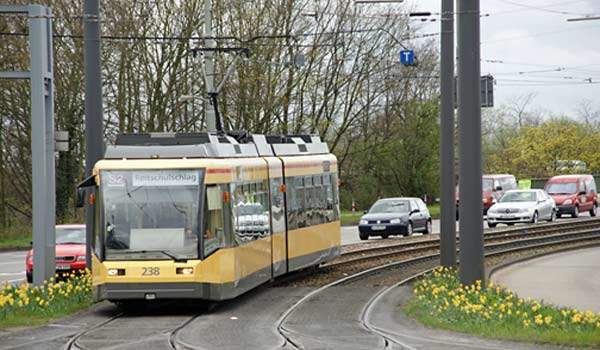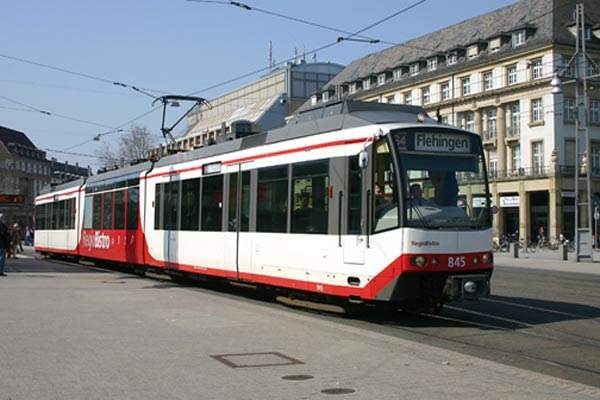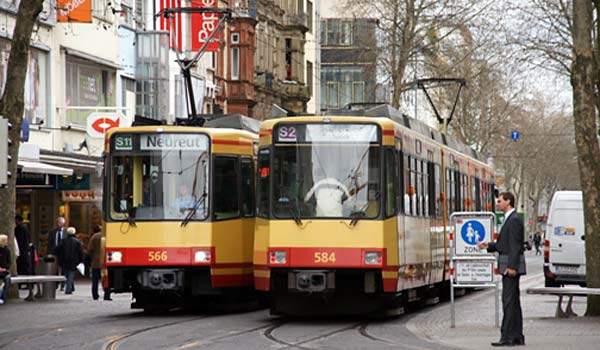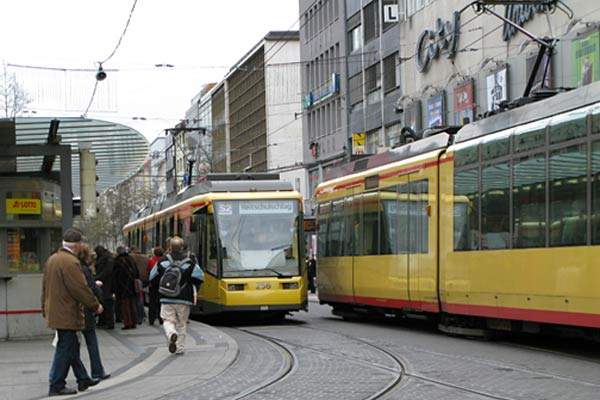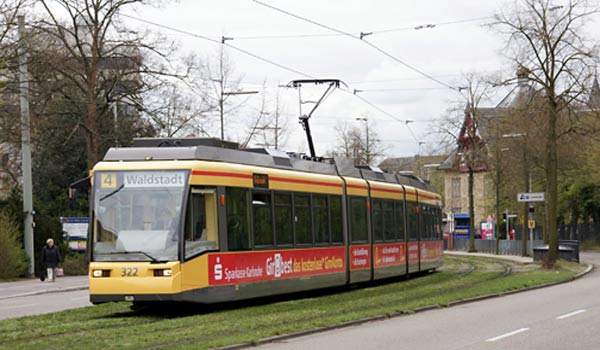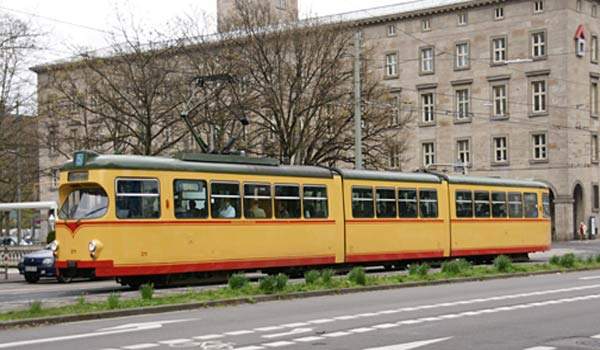Close to the French border in south-west Germany, Karlsruhe in Baden-Württemberg was the first European city to implement track-sharing for light and heavy rail vehicles. The ‘Karlsruhe Model’ is considered the reference point for similar developments worldwide.
With a population of over a quarter of a million, Karlsruhe did not warrant a free-standing S-Bahn network, although services were to carry ‘S’ route designation and the S-Bahn symbol used extensively. However, it was keen to link urban and rural areas largely using available trackwork, enabling passengers to travel into and out of the city centre without having to change rail vehicles and overall to discourage road use. A combined light / heavy rail system was seen as the most viable solution to meeting increasing demand.
Now owned by the local authority and represented under the Karlsruher Verkehrsverbund (KVV) identity, pioneering developers were Albtal-Verkehrs-Gesellschaft GmbH (AVG) for the regional light rail and dual-mode operation and Verkehrsbetriebe Karlsruhe GmbH (VBK) for the urban tramway and bus network.
The project
Development began in 1975, with the building of an extension of the urban tramway to the new housing area of Nordweststadt. This was the first phase of what has become the trams’ northern network, or Hardtbahn, which runs into the city from the north-west at Hochstetten, and serves Bruchsal, Bretten and Golshausen in the east. The opening of a northwards extension to Leopoldshafen coincided with a major reorganisation of public transport in the area.
The success of the Albtalbahn and Hardtbahn prompted a study into how other communities around Karlsruhe might benefit from similar light rail links into the city.
Deutsche Bahn (DB) operated several local services into the city, of which those, to Worth and Bretten, were identified as being particularly suitable for interchange between light and heavy rail. The Siemens engineering works was linked to the network in May 1989, and a line subsequently extended a further three stops to Kneilingen Nord.
A world first, through-running of tram vehicles on a national heavy rail network began on 28 September 1992.
Infrastructure
Originating with the Albtalbahn company converting its metre gauge tracks to 1,435mm, in turn joining with the extant Karlsruhe tram network to enlarge the system, the radical change was to physically link operations to heavy rail. Detailed negotiations with DB resulted in signing a deal to build, finance and operate the 28.2km Karlsruhe-Bretten Stadtbahn. Initial light rail adaptations were completed by DM45m (£15m) worth of modifications, including building eight new stations.
Karlsruhe’s system has been built at a relatively low cost, with little disruption for civil engineering works. For example, relaying of tracks through Durlach to the east of Karlsruhe in late 1999 was completed with one line kept in operation throughout.
The second section of Stadtbahn from Karlsruhe to use DB passenger tracks runs to Wörth, where the town council unanimously approved an extension of the line along the model of the Bretten example. This leaves route one at the Siemens interchange and runs to Knielingen, where it joins the DB lines as far as Wörth.
Not all communities have welcomed the opportunity to join the network, exemplified by local opposition holding back projected extensions into central Rastatt and Baden-Baden
Rolling stock
Because of the different electrical supply systems of the light and heavy rail networks, research was carried out into a two-system vehicle. A DC-AC system with on-board transformer and rectifier was chosen. Changeover between the two power systems is carried out automatically and on the move.
In addition to dual voltage capability, the 800-series dual system vehicles (Zweisystemfahrzeug) vehicles from Düwag (now Siemens) are also are compatible with DB signalling. Fitted with rail brakes for shorter stopping distances, the cars have an all-steel body, and are equipped for multiple operations.
Aside from the convenience of seamless transfer between rail networks, the tram-trains were able to decrease previous journey times by more rapid acceleration and braking.
Interior fitting was completed by Düwag, and this achieved one of the lowest interior noise levels of a car of its kind, even over the city centre’s grooved rails. For longer services, some vehicles are equipped with toilets and bistro cars, although the latter did not prove commercially successful in normal operations.
The future
Karlsruhe tram-train operations have continued to expand such that distant centres such as Heilbronn, Pforzheim and Bad Wildbad have become part of the system, with mainline running commonplace. The AVG’s longest run is now a 210km (130 mile) S4 service from Öhringen through central Karlsruhe to Achern, south-west of Baden-Baden.
Around 2km of track including several junctions through Karlsruhe city centre run east-west along Kaiserstrasse, the main shopping street. Largely pedestrianised, the section carries an intensive service of tram-trains and trams due to the convergence of many routes. This has effectively become a limiting factor in further system enlargements.
Under the ‘City 2015’ banner, KVV subsidiary Karlsruher Schieneninfrastruktur-Gesellschaft mbH (KASIG, constituted May 2003) is promoting the construction of a tunnel with a southern branch from Marktplatz to Augartenstrasse to carry much of this traffic, with tram routes remaining at grade.
Estimated to cost €500m, this major infrastructure project, which also contains some new road tunnels, would return the centre more to pedestrians and significantly increase rail capacity.
Although a development that has encountered resistance, KASIG plans for construction to begin by 2010 for a 2015 completion.
The term ‘Karlsruhe Model’ has passed into rail vocabulary to describe street-to-main line operations and has inspired system developments in nearby Saarbrücken, Kassel, the RijnGouweLijn project in the Netherlands and the future system centred on Mulhouse in France.

